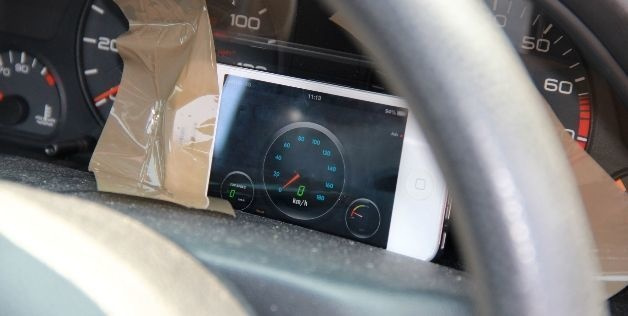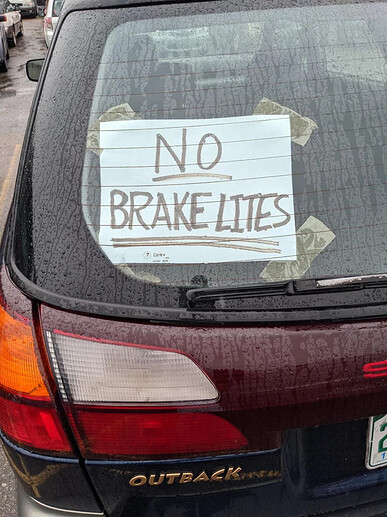1. It’s Nightmare Storytime!
Even if you do not own a car, you can’t escape the nightmares – your car-owning friends certainly shared their stories of car repairs, in exchange for much needed comfort. Now, every failure of a car is either mechanical or electrical related. The mechanical ones are as old as horseless carriages … even carriages with horses had them, in addition to biological failures. But electrical and especially electronic failures, that’s a novelty. And that is what automotive nightmares are made of.
Do your brake issues cause you nightmares? Here’s an easy fix!
(source: user Boosted3232, via Reddit)
What follows is empirical anecdotal evidence. (Empirical? Because you can ask any car mechanic in high-income countries and will get anecdotes just like these, as many as you care to listen to.)
Keys

Do your central locking system issues cause you nightmares? Here’s an easy fix.
(source: user Funky_Pickle, via Reddit)
Electronic car keys are our first nightmare. Made from a thin plate of ferrous metal in times past, they are now apparently made from a platinum alloy. Or how else are we supposed to explain that “A replacement for your spare electronic car key can cost between $250 to $750. However, if you have lost all your keys, you need to reset your car’s computerised system, then create and code an entirely new set of keys. This can cost around $2,000 to $5,000.” (source). To give an example, somebody was quoted 1200 EUR for a new key for their Mercedes car (source).
Lights

Do your automotive light issues cause you nightmares? Here’s an easy fix!
(source: 20 Hilarious Car Repairs That Are Just Too Brilliant To Be Wrong!)
Somebody’s right fog lamp failed. Spare parts would be around 4.50 EUR even if the bulb, wire and fuse would all be broken at the same time. But we live in modern times. Now the spare was around 450 EUR (and 150 EUR for testing and repair) for a little black box (literally black) answering to the name of 3C8937049AC that was at fault (source, German). Didn’t car lamps work just fine with wires, bulbs and fuses in times past? What exactly does this black box with electronics (“ECU”) do, except breaking down?
Another person’s headlights failed. Since these were xenon lights, they were a bit, umh, complex. The lamps themselves plus their companion black boxes with electronics had to be replaced. The cost? 950 EUR (source).
Instruments, sensors, everything really

Do your automotive instrument issues cause you nightmares? There’s an app for that!
(source: 40+ of the Most Hilarious DIY Car Repair Fails of All Time)
A month later, our troubled protagonist with headlights issues from above was hit again with car nightmares. His dash instruments were acting up and the whole car was not running properly anymore (source) … the engine had very little power output, was not taking accelerator input properly, and the brake was not working. (Turns out, the brake issue was “only” because the engine was silently dying while driving so that the engine-supported brake did not brake properly anymore (source) – umh, how comforting that the brake still worked but only appeared to not work.) Anyway, not drivable anymore, and the official repair shop could not find any issue (source) (in other words, they were overwhelmed by this problem). Anyway, 160 forum messages later they had figured out this issue together (source). And the culprit was: a defective crankshaft position sensor. These defects do not show up in the self-diagnosis system of the vehicle electronics as the vehicle has no way to check the plausibility of the sensor values, but apparently their malfunction is the only sensor malfunction that can cause the engine switch off (source). Spare part cost for the sensor was just 40 EUR (source). The cost of figuring out the problem, if paid at commercial rates, had probably been 100 times that. Add to that the multiple parts that repair shops usually replace while looking for the issue (example, for the same symptoms) and it amounts to a total economic loss of the vehicle due to … a part that sells for 40 EUR here and is manufactured for maybe 5 EUR by our industrious Chinese friends. If that does not cause you nightmares, you’re living too long on this planet already! ![]()
Reports of electronics failure can be so unexplainable that we should accept the “ghost in a machine” hypothesis as the most likely. Or how do you explain this?
A long time ago, for example, I had a Lada Samara. Its engine always went out at a certain traffic light on my way to work when the traffic light was green. The engine only started again as soon as the traffic light showed red again. So, it was bad luck when I had to stop at this traffic light of all places. There were always few funny horn companies from the following motorists. My car workshop told me I’m crazy when I described the issue. But when I let the workshop foreman come along for a demonstration, they stopped laughing. (source, translated to English)
Oh, and I have one more like that, my personal favourite. A friend’s brother whose VW Touran diesel car did not start anymore. None of several workshops could figure it out, so he asked my friend to just sell it as broken. My friend takes it to his place but does not want to give up on it so easily. But can’t figure it out either. So he just leans on the car and prays for it. From right then and there, it started reliably again. They still sold it shortly afterwards, because, who knows how long that treatment lasts.
Even battle tanks, the most indestructible of all vehicles, are easily taken out of action nowadays by pulling on a cable or other electrical component. When I was in the military, I found a damage report in our tank unit of Leopard 2A5 main battle tanks. Somebody had stepped on something wrong upon leaving the tank through the turret hatch, and that broke one of the tank’s electronics boards. Repair costs were roughly 10,000 EUR in today’s money (I don’t remember exactly).
2. The Appropriate Car
Appropriate technology is about “technological choice and application that is small-scale, affordable […], decentralized, […] energy-efficient, environmentally sound, and locally autonomous […] The term appropriate technology is also used in developed nations to describe the use of technology and engineering that result in less negative impacts on the environment and society, i.e., technology should be both environmentally sustainable and socially appropriate.” (source; leaving out “labor-intensive” because that’s about job creation, not the use of technology).
Well, sweet! If that isn’t what we want from technology, I don’t know. Those modern, electronic-filled, automobile shaped nightmares from above are however quite far off the mark. With all their absurdly cushioning comfort, they even fail in providing us with valuable human experience, as we shall see in a later piece. In other words, there is a good amount (but not complete) overlap between less wasteful car electronics and what car users need and sometimes demand.
But just how became cars such a nightmare? That’s a good question (and you’re welcome to join the discussion below). Here’s a very limited, mechanistic perspective: since new cars still last three years before the maintenance and repair nightmares begin, this fragile technology does not cause nightmares to the immediate, paying customers: those purchasing or leasing new cars, and switching them for another new one after one to a few years. Cars are made as impressive high-tech packages that last these first few years, often sold or rather leased as a mobile booster for social status, and directly fund automakers in that role. After that, automakers do not care, beyond making a mint of money from excessively priced spare parts and repairs. Second-hand owners care, though. The environment cares. Future people care about the wasteful practices of today.
That brings us to another good question: what can be done. I’ll start with a few ideas what can be done with technology alone, and you’re very welcome to expand on that and also to add policy, sociological, business and metaphysical perspectives in the discussion below:
-
Reduce. The first commandment in “Reduce, reuse, recycle”. What is not there cannot break. All the electronics in optional extras are not necessary, otherwise these would not be called “options”. Similarly, many separate electronic devices can be merged into a universal one, as demonstrated by smartphones and their apps, and as also demonstrated by the “single large screen” user interface of Tesla’s cars.
-
Learning from repairs. There are already a few companies that offer to repair automotive electronic units, for 15-30% of an original new spare part. When doing the repairs is when you learn how your products break. It’s also much more environmentally friendly than just replacing one piece of electronic junk with another, which is how cars create issues of electronic waste during their lifetime. So, manufacturers should be doing the repairs themselves, and somehow have the incentives to improve their products from what they learn. A lifelong “right to have it repaired” might help: as a customer, you’d still have to figure out which part is broken, but then getting it repaired would be free of charge.
-
Constant evolution, not fast fashion. New passenger cars are positioned as lifestyle products that follow fashion trends paced in model years and distinguished by design and luxury features. Such an environment eliminates the benefits of learning from previous failures: every switch to a new model translates to hundreds of changes, so that learnings can not be applied unmodified. And of course, all these changes introduce more weaknesses as well. Beyond a certain rate of change, learnings from previous failures are worth very little. What we need is car models that are built for decades in a kind of slow evolution. The emergence of luxury and vanity features indicates a certain maturity in the development of a product’s core functionality. Of course, with the switch to electric cars we will have another few years of fast advancing technology, but after that, it’s the right time for a constant evolution towards reliable and appropriate technology.
-
Redundancy. Automakers sometimes use a single level of redundancy, as employed or at least proposed by Tesla for data cable wiring (source) and used by Tesla for their self-driving control computers (source). However, that is for operational safety: the vehicle will not fail immediately, and the redundant system can be used until the failed part is repaired in the near future. But with more than one level of redundancy, it would actually be acceptable for a part to fail, without the car requiring a repair of this part in its lifetime. Note also how redundant sensors allow to detect a sensor fault by comparing their values – a good strategy to avoid cases like that of the faulty crankshaft sensor from above, which did not and could not show up in the self-diagnosis system as there was no way to cross-check its values.
-
Expert systems for failure diagnoses. I quite like the idea of failure self-diagnosis, as already implemented in cars. But not the way it is implemented. The first issue: display the actual meaning of current error codes on a screen in the car’s main digital screen. That’s empowering the users; otherwise, we’re forced to empower ourselves by buying Chinese and Russian reverse-engineered diagnostic devices. The second issue: no self-diagnosis system will ever be perfect, even with redundancy, as failures are by nature unpredictable. Currently, “diagnosis” then happens by exchanging possibly defective parts, paid for by the car owner, until the actually defective one has been isolated. That is wasteful, and can be improved by an expert system in which everyone doing car repairs can enter their repair results in a structured way. It’s for providing repair advice like an Internet forum now, only better.
-
Longevity requirements. One point that wades into policy realm. I don’t get how policy makers care about ever-stricter emission regulation for cars, but not about the wastage of critical raw materials and of energy by short lifetimes of cars and car parts, especially electronic ones. A car, including its electronics, that lasts five times as long has an 80% lower resource consumption of all raw materials even in the absence of recycling. And such a lifetime is not unrealistic, as demonstrated by commercial trucks. Tesla’s CEO Elon Musk is on record for saying that “Model 3 drive unit and body is designed like a commercial truck for a million mile life.” (source). Even in case the average Tesla Model 3 cannot live up to that – this is the direction to go, and this is what policy makers must tell automakers so they will tell their engineers. The price for a new vehicle may rise, but the resale price will also be higher – so first-hand owners will not care, and second-hand owners will be thankful for a more reliable vehicle.
That’s enough of tech proposals, because surely better tech alone will not get us out of this nightmare. It rather seems to me that the whole value system of our current culture is at fault, enabling such a poor creation and experience as that of today’s cars. I leave you with a quote from "Zen and the Art of Motorcycle Maintenance” for now (actually the most-sold philosophy book of all time). We can explore the implications on cars together.
“[J]ust stare at the machine. There’s nothing wrong with that. Just live with it for a while. Watch it the way you watch a line when fishing and before long, as sure as you live, you’ll get a little nibble, a little fact asking in a timid, humble way if you’re interested in it. That’s the way the world keeps on happening. Be interested in it.”






